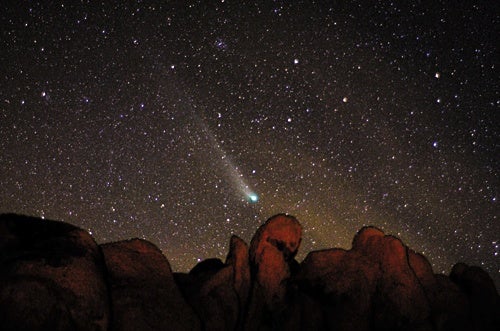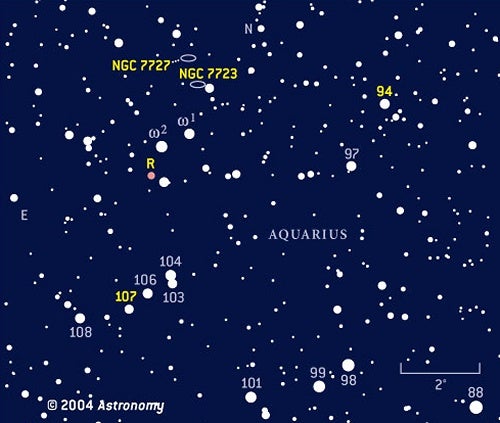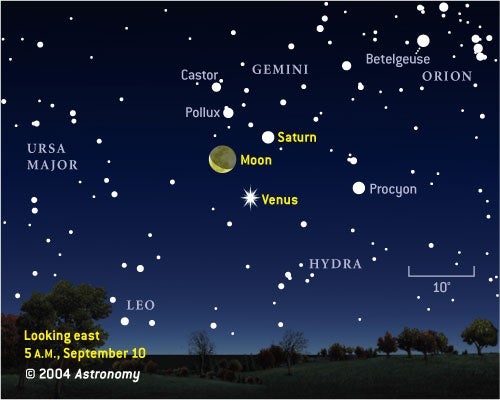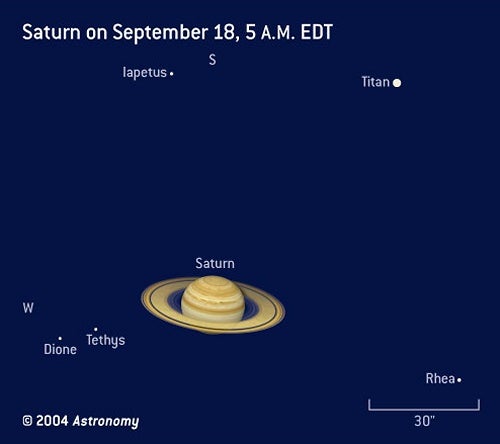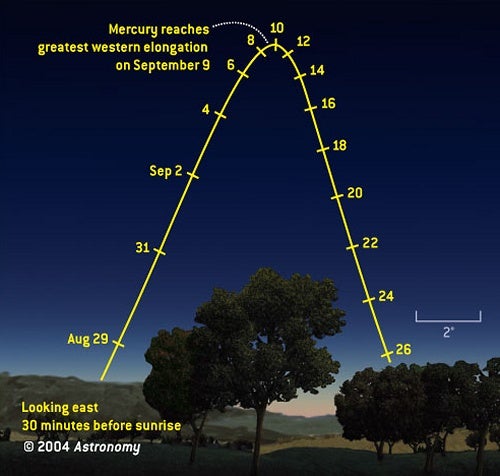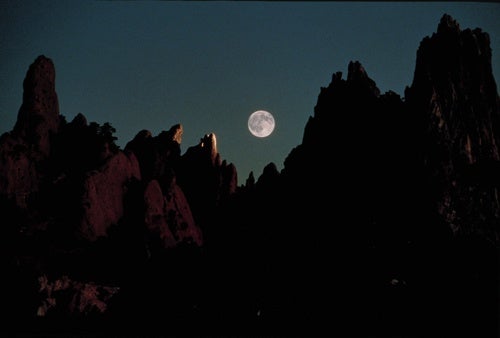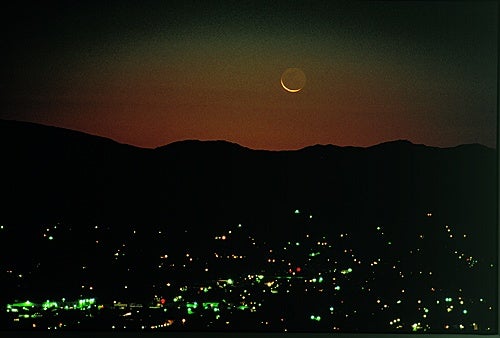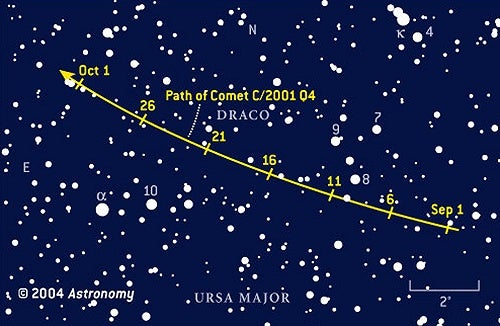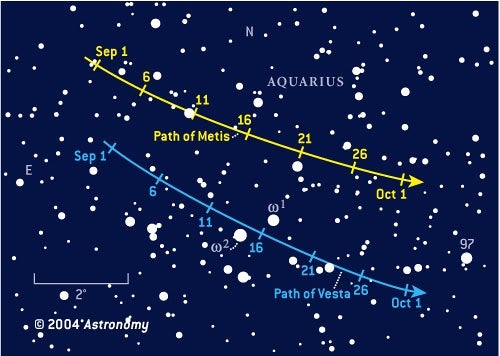Steady, transparent skies are a frequent hallmark of early autumn. For observers in much of the Northern Hemisphere, September ranks among the best months of the year — it’s common to have good weather on at least half the nights.
This month, all the bright planets either hide behind the Sun or show up in the predawn sky. The faint outer trio — Uranus, Neptune, and Pluto — stay available for evening stargazers. Glowing at magnitude 5.7, Uranus is bright enough to detect without optical aid from the country. With binoculars, it’s a snap to find from a suburban backyard. Not far from Uranus, and nearly as easy to locate, lies Vesta, the brightest of all asteroids.
For the best views of the comets, develop a defense against dew. The rapidly dropping temperature after sunset at this time of year favors the development of this nefarious destroyer of high-contrast views. For owners of SCTs and refractors, arm yourself with a heated dewcap to keep exposed surfaces above air temperature. A hair dryer will do in a pinch, but slow, gentle heat works best. Even big mirrors can succumb, so think about heating them, too.
The Moon begins September just past its full phase, which it reached on the night of August 29/30. The best dark-sky views will come in the week that brackets New Moon on September 14. Once the Moon hits full phase again late in the month, the Harvest Moon effect takes over. For several nights in a row, the Moon rises slightly later than the previous night. (See “Meteors and moons” on page 62 for details on why this effect takes place.)
If planets are your passion, you’ll have to rise before dawn to catch them. In early September, Saturn and Venus breach the eastern horizon together in the wee hours of the night. The two drift apart slowly during the following weeks as Saturn climbs away from the Sun and Venus falls toward it. You might notice that Saturn’s rings have started closing up, heading for an edge-on appearance in 2009.
Venus now floats as high in the morning sky as it did in the evening sky this past spring. The crescent Moon passes it on the morning of September 10, which coincidentally makes a great time
to spot Mercury at its best. During the next few months, Venus will cruise back toward the horizon and meet with the other bright planets, including a gorgeous pairing with Jupiter on November 5.
Mercury has an impressive morning apparition this month. Keen skywatchers should be up around 5:30 a.m. local daylight time on the 10th to see the speedy messenger skim past Leo’s brightest star, Regulus. Through a telescope, try following them into daylight as they separate slowly. Mercury appears the brighter of the two, a yellowish, -0.4-magnitude object compared with the star’s bluish, 1.4-magnitude sparkle. During the next few mornings, Mercury brightens further but heads back into the twilight glow.
Water in a dry sky
As creatures of habit, we inevitably turn our eyes toward the east to see what’s new coming over the horizon. As you can see on the circular foldout map, the Great Square of Pegasus greets us with its bold outline on September evenings. Heading south, a bit to the lower right, we pass through the Circlet of Pisces into the liquid world of Aquarius the Water-bearer. You’ve gone too far if you land on the bright star Fomalhaut, twinkling
close to the horizon.
Now ask yourself: Does R Aquarii look the same, a bit brighter, or a bit fainter than the comparison stars? You can make this simple and quick estimate useful scientifically by recording the time of your observation and sending the estimate to the American Association of Variable Star Observers (AAVSO). Last summer, R Aqr crested a full magnitude brighter than its typical maximum. What will it do this year?
You can download a free comparison star chart from www.aavso.org. At the top left, where you see “Pick a star,” click on “Chart,” type in “R Aqr,” and click “Submit.” If you check R Aqr every couple of weeks through the end of the year, you’ll notice it growing dimmer and redder.
Through a telescope, you often can find stars nestled close together. About 5° west of Omega lies 94 Aqr, a line-of-sight pair. At low power, it looks like a single star, although you might not be able to focus it to a point. Bump the magnification up to 100x to see it split into an unequal pair. Some 4° south of Omega lies a slightly tighter duo that’s also closer in brightness. The separation between the two stars of 107 Aqr is 7″, about twice the gap between the famous Double-Double components in Lyra.
Between 1° and 2° north of Omega1 Aqr — and about 100 million light-years farther away — lie the galaxies NGC 7723 and NGC 7727. NGC is short for New General Catalogue of Nebulae and Clusters of Stars, which was compiled in the 1880s and is the master reference of all the deep-sky discoveries of the great visual observers. Up until John Dryer corralled several smaller catalogs into a cross-referenced, unified whole, the state of the fuzzy sky was filled with positional discrepancies and multiple names.
 |
 |
| Spiral galaxies NGC 7723 (left) and NGC 7727 (right) in Aquarius the Water-bearer make tempting targets for observers with 6-inch or larger telescopes. Digitized Sky Survey | |
At magnitudes of 11.2 and 10.6, respectively, NGC 7723 and NGC 7727 glow fainter than the best and brightest the sky has to offer. To see them through a 4-inch telescope,
you should be out under a dark country sky during the second week of September, when the Moon is out of the sky. Increase the magnification to 100x or so to darken the background sky and increase the size of the small fuzzies.
Two gas-giant planets, Uranus and Neptune, occupy the evening scene, and you can spot them with binoculars if you’re observant. By 11 p.m. local daylight time in early September, Neptune lies due south in Capricornus. This constellation appears rather faint, so viewing from the city will render most of its stars invisible. Binoculars will help you locate Neptune easily, however, because the planet lies close to the 4th-magnitude star Theta (θ) Capricorni.
Uranus proves much easier to view than Neptune because it glows brighter and displays a larger disk in a scope. This happens despite the fact the two planets have nearly the same physical diameter. The culprit — distance. Uranus lies only two-thirds as far from Earth as Neptune does.
Uranus resides in central Aquarius, near the star Sigma (s) Aquarii. As September opens, the planet lies 0.9° west of this 4.8-magnitude star. Uranus glows a little fainter, at magnitude 5.7, although it’s still an easy target for binocular users. Those blessed with an inky-black sky should be able to spot it with the naked eye. Uranus reached opposition during the last days of August, so it remains due south around local midnight in early September. Its nightly motion against the background stars carries it westward until late October, when it resumes its normal easterly path.
An entourage of bright planets can be found in the
sky before dawn. An exquisite pairing of Saturn and Venus dominates the morning scene. On September 1, both planets rise some 4 hours before the Sun and stand high in the east as twilight approaches. Just 2° separate the pair. Venus outshines Saturn by more than fifty times, with Venus at magnitude -4.2 and Saturn at magnitude 0.2. Saturn sits 7° south of the star Pollux, which joins with Castor to form a second familiar pair in the constellation Gemini the Twins.
Venus begins to drop away from Saturn at a rate of almost 1° per day. A waning crescent Moon passes 7° north of Venus on September 10, forming an attractive sight. Through a telescope that morning, Venus appears 19″ across and shows a 62-percent-lit phase, a marked contrast to the 17-percent-lit lunar crescent. Four days later, on September 14, Venus lies 2.5° south of the Beehive star cluster (M44) in Cancer the Crab. For the remainder of September, the “morning star” approaches Regulus in Leo the Lion, ending the month 4° from this 1.4-magnitude star. The gap tightens significantly in the first few days of October.
A small telescope also reveals several saturnian moons. The brightest is Titan, which glows at magnitude 8.3. You can find it due north of Saturn on September 9 and due south on the 17th. On the morning of the 16th, Titan and the variable moon Iapetus lie close to each other, with the latter glowing at 11th magnitude. Iapetus remains one of the most intriguing moons in the solar system, varying in brightness by a factor of five during the course of its orbit. At greatest western elongation, it glows at magnitude 10.1 (this occurred on August 29). Six weeks later, on October 9, it reaches greatest eastern elongation and appears much dimmer at magnitude 11.9.
This ranks among the best of Mercury’s 2004 morning apparitions. On September 10, the same day the crescent Moon sits near Venus, Mercury lies close to the bright star Regulus in Leo. Only 0.3° separates the two, placing both objects within the same telescopic field of view at medium power. The planet displays a 7″-diameter disk that’s half-lit.
Mercury brightens during September, surpassing magnitude 0.0 on the 8th, while its diminutive disk shrinks as the planet falls back toward the Sun. On September 13, the planet stands 5° to the upper right of a very thin crescent Moon. By the 20th, Mercury shines at magnitude -1.1 and lies very low in the eastern predawn sky. It disappears from view soon afterward.
Neither Mars nor Jupiter can be seen this month. They pass behind the Sun within a week of each other in mid-September. Jupiter returns to view in October while Mars waits until November.
The autumnal equinox occurs at 12:30 p.m. EDT on September 22, marking the moment when the Sun crosses the celestial equator heading southward. The Sun then lies in the constellation Virgo.
A September lull
No significant meteor shower takes place in September.
One minor shower, the Delta Aurigids, remains active for most of the month. Rates are low, however, with less than five meteors per hour expected even when the radiant is high in the sky. Even worse, the waning crescent Moon sheds some unwanted light at the shower’s peak on September 9. A weaker, secondary peak occurs around the 23rd, with perhaps brighter meteors than the earlier peak.
Two intriguing Moons
Instead of narrowing our focus to an individual lunar feature, this month we look at the big picture. Mid-September offers a great opportunity to spot an exceedingly thin lunar crescent, while the end of the month brings with it the annual Harvest Moon.
The term “old Moon” refers to the last stages of the lunar month, just before the waning crescent Moon gets reborn at New Moon. The morning sky in September proves conducive to seeing an old Moon because the ecliptic — the apparent path of the Sun across the sky that the Moon also follows closely — inclines steeply to the eastern horizon for observers throughout the Northern Hemisphere.
Seeing such an old Moon requires a special set of observing conditions — as well as good timing. You’ll need both an unobstructed eastern horizon and excellent atmospheric transparency. The slightest bit of haze can block the narrow crescent from view.
Observers living farther to the west will have an increasingly difficult time spotting the lunar crescent. On the West Coast, the Moon is just 25 hours from its new phase and has slid even closer to the Sun. By the time the Moon pokes above the horizon, it lies 6° to the lower left of Mercury and will be very difficult to see. However, the potentially clear desert air of the southwestern United States should increase the odds.
The ecliptic also plays the key role in September’s other major lunar event. The Harvest Moon is just another name for the Full Moon occurring nearest the autumnal equinox. It gets its name because the Moon rises only a bit later each succeeding night, and the bright light above helps farmers bringing in their crops.
For the Harvest Moon, the ecliptic has an opposite effect from what it has at old Moon. When night falls in September, the ecliptic makes a shallow angle to the eastern horizon. Imagine the Moon just clearing the horizon on the night it is full (September 28 this year). At the same time on the next night, the Moon doesn’t lie very far below the horizon because it has been traveling nearly along the ecliptic. That means the Moon doesn’t rise that much later than it did on the previous night, an effect that persists for several days.
Evening comets galore
Comet C/2003 K4 (LINEAR) continues to brighten into easy binocular range. Expected to glow around 6th magnitude, this dirty snowball should show a central condensation surrounded by a fading halo. Binoculars should reveal the comet as a fuzzy “star” to the lower left of 3rd-magnitude Epsilon (ε) Virginis, which lies below the bright orange star Arcturus in the western sky as darkness falls.
Nicely placed from the Northern Hemisphere, Comet C/2001 Q4 (NEAT) continues to sail across the back of Draco the Dragon. Although the comet is well past its spring peak, it still compares favorably with the brighter galaxies of the Messier catalog. Because the comet lies so far north, it remains circumpolar throughout most of the United States, meaning it stays above the horizon all night.
During the first half of September, observe Q4 in the early evening hours, when the Moon’s interfering glow remains out of the sky. During the second half of the month, when the Moon has moved to the evening sky, switch to a predawn observing session.
Deep-sky observers and astro-imagers will want to keep their eyes out for a third comet. C/2003 T3 (Tabur) will be in conjunction with the spiral galaxy NGC 3198 in southern Ursa Major on the morning of September 17. Both the comet and the galaxy glow around 11th magnitude.
When an object lies due south around local midnight, it also lies opposite the Sun in our sky. That’s why astronomers use the term opposition to describe this configuration. Typically, opposition also means that the object lies closest to Earth and thus appears at its brightest. This holds true in September for the fourth asteroid to be discovered: 4 Vesta.
Vesta is a large chunk of rock some 330 miles (530 kilometers) in diameter. Its surface must consist of a really light-colored soil because it reflects light some seven times better than the Moon’s darker regolith. All these factors combine to give Vesta a glow of magnitude 6.1 when it reaches opposition on the night of September 12/13, making it just visible to the naked eye from a dark site. The brightest stars in the area, Omega1 (ω1) and Omega2 (ω2) Aquarii, lie to the right of the tip of Cetus the Whale’s snout.
Use the chart above to zero in on Vesta. The chart shows stars down to magnitude 9.5, so the asteroid should be easy to pick out through binoculars. Its nightly motion should be easy to track, too. If you want a small-scope challenge, try finding the asteroid 9 Metis. This smaller object parallels Vesta’s course 2° to the north. Metis reaches opposition a night after Vesta, when it glows at magnitude 9.1, just 6 percent as bright as its companion.
Perhaps the most intriguing asteroid this month is 4179 Toutatis, named after a god of the Gauls and made famous in the comic strip Asterix. As its number implies, this Earth-crossing object was discovered fairly recently. It glows faintly except during its rare, close passages by Earth — one of which occurs late this month. Watch for detailed finder charts in the October issue.

